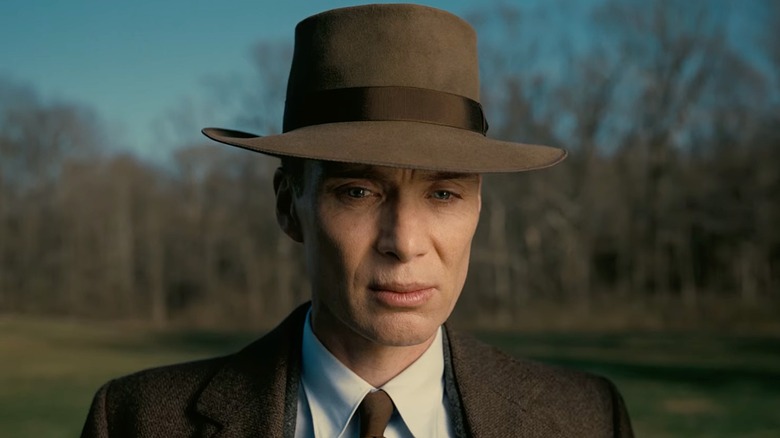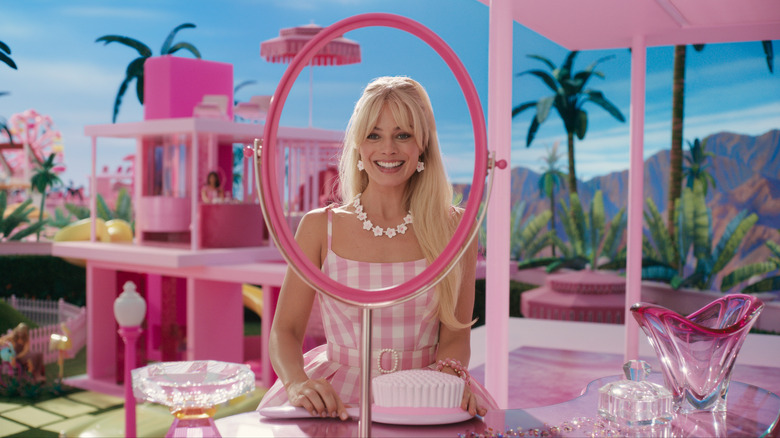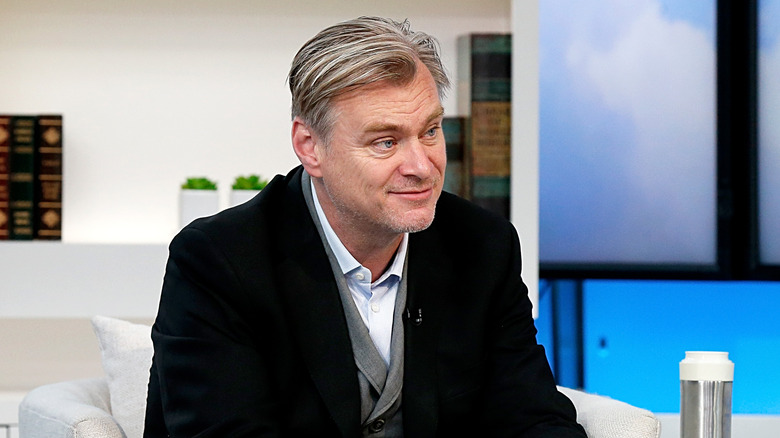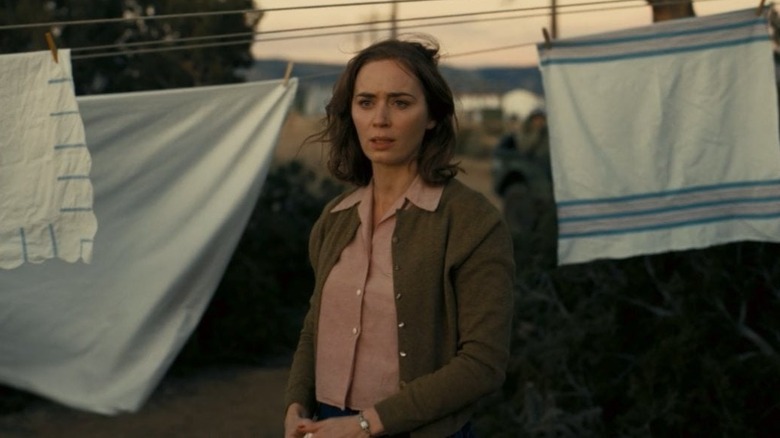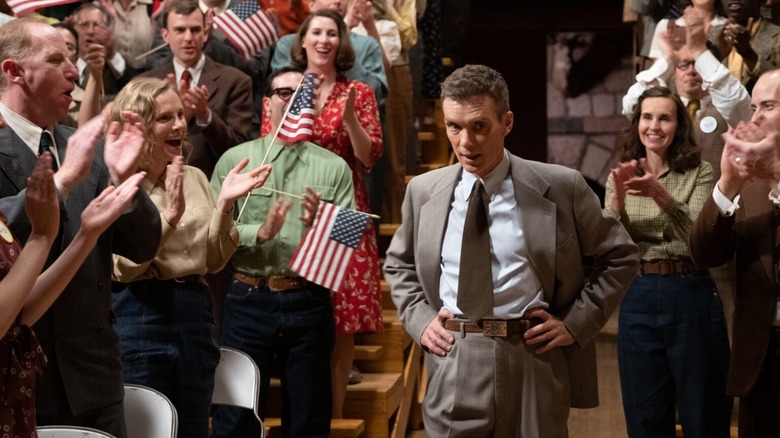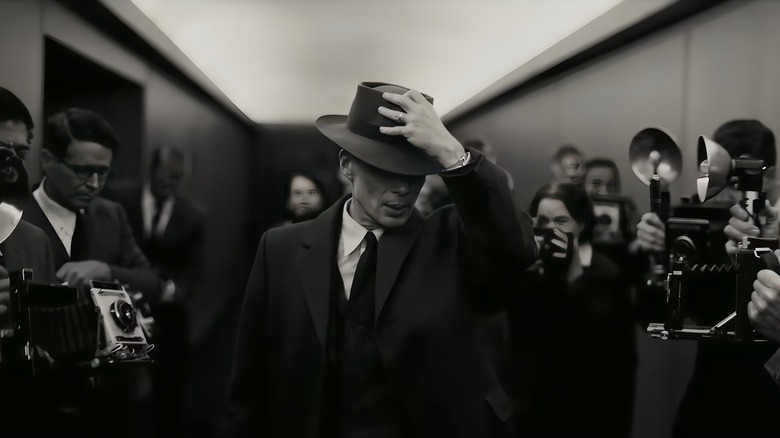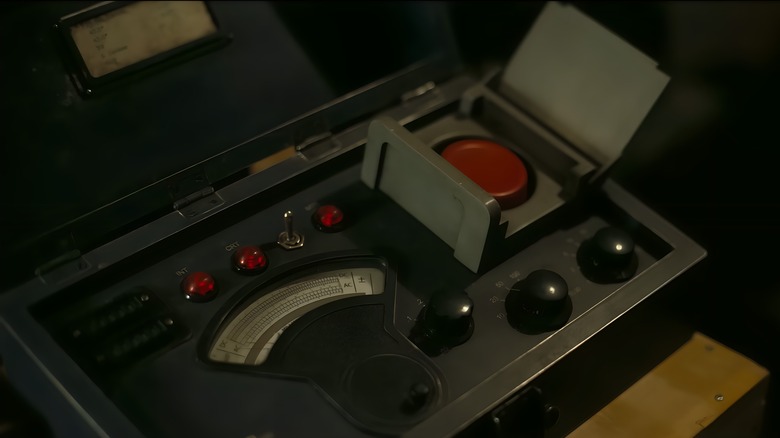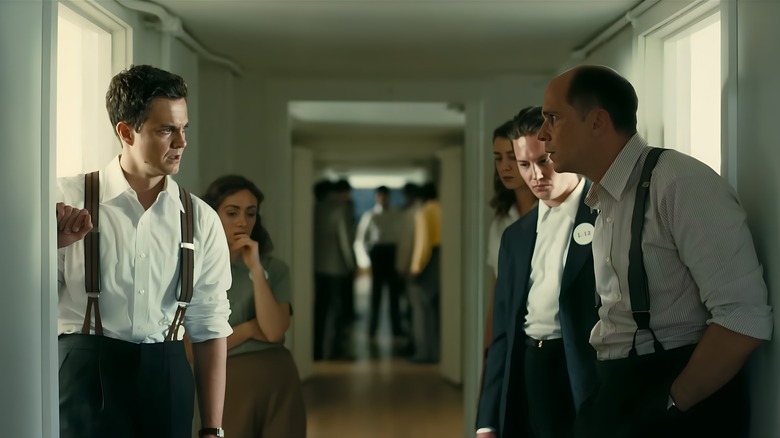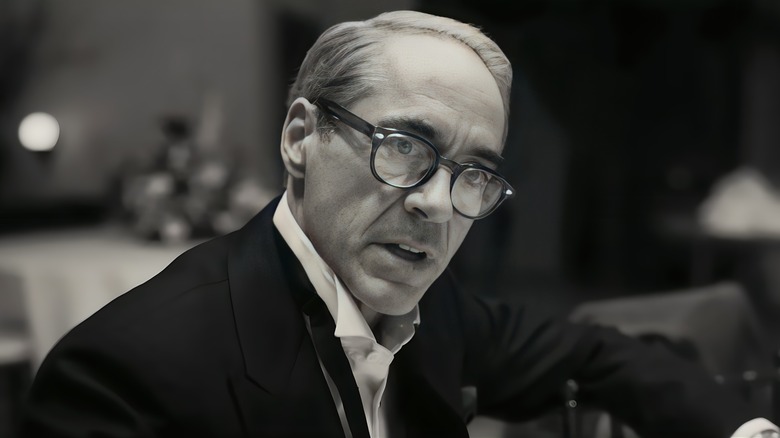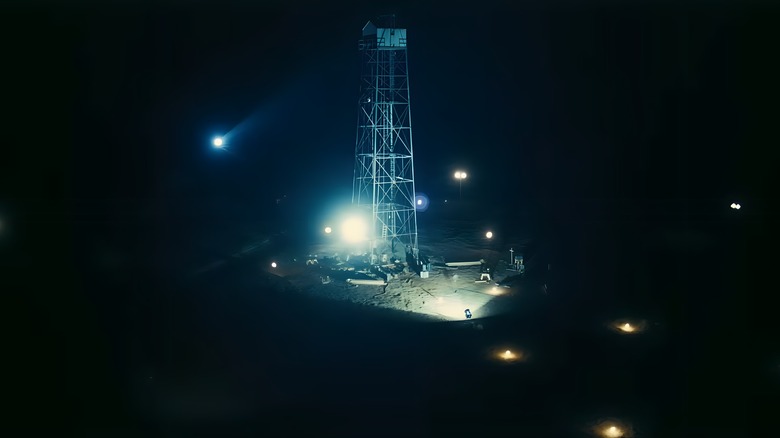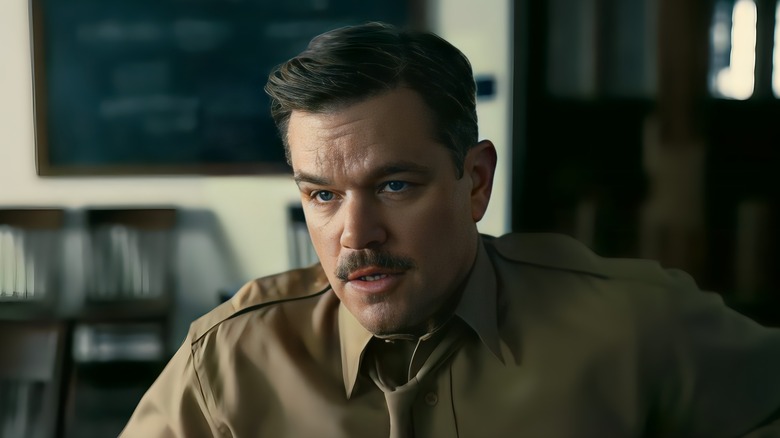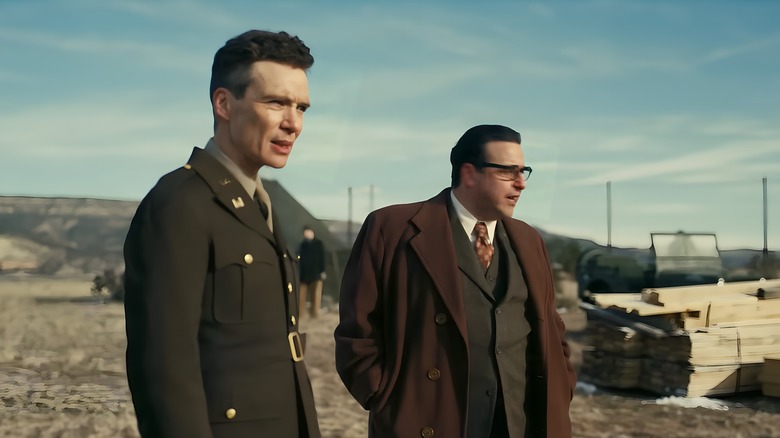Why Oppenheimer Blew Us Away At The Box Office
This article contains spoilers for "Oppenheimer"
"Oppenheimer," Christopher Nolan's cautionary tale about the two-sided nature of technological advancement, scored rave reviews and made serious cash at the box office when it hit cineplexes in July 2023. According to Deadline, the film wrapped up its opening weekend with an $82.4 million domestic total. That is a massive number and double what some pundits were estimating. The international number was even higher, leading Nolan's epic biopic to a mammoth $180 million opening weekend worldwide, per Variety.
While impressive, these aren't unprecedented numbers, nor do they compare with the family-friendly film "Barbie," which dropped at the same time and pulled in nearly twice as much at the domestic box office on opening weekend. Nevertheless, there's no doubt that the success of Nolan's World War II/Cold War film is a serious achievement. Remember, we're talking about a three-hour, R-rated drama primarily focused on scientists in fedoras and lab coats. Heck, it doesn't even show the bombings of Hiroshima and Nagasaki, events that many viewers undoubtedly expected to see.
So, what is it that made a film this unique such a smash hit at the summer box office right out of the gate?
Oppenheimer benefited from the Barbenheimer effect
Let's start with the elephant in the room. "Oppenheimer" was pitted against the Margot Robbie-led "Barbie" from day one. In the lead-up to the film, the competition between these two diametrically opposite stories was obvious everywhere, so much so that the experience was quickly dubbed "Barbenheimer" by avid fans from both camps. Mattel's movie, helmed by the immensely talented Greta Gerwig, was guaranteed to attract a massive millennial following (along with their own offspring) in the name of nostalgia. At the same time, "Oppenheimer" had a disturbingly fatal attraction for countless viewers due to the many other reasons included on this list.
This led to one of the strangest standoffs that we've seen at the box office in ages. Two heavyweight movies, each able to hang with the best of them and bring their own fanbases to theaters at the same time. They went toe-to-toe on opening night, and, in many cases, movie-goers embraced the friendly competition by booking back-to-back showings. The result was a surge of marketing momentum that benefitted both films. Even if "Oppenheimer" came in a distant second at the box office, there's no question that both movies were better off for the mutual energy stemming from the rivalry of two of the strangest bedfellows in cinematic history.
Nolan's reputation was a factor
It's a well-known fact that Christopher Nolan doesn't make bad movies. We're not saying all of his movies are classics, but the renowned Brit has a sensational track record. Since breaking through with his sophomore feature film "Memento," Nolan has been on a quarter-of-a-century hot streak. His style isn't for everyone, but there's no doubt that it's distinct, exciting, and always leaves fans wanting more.
One of the signature elements of every Nolan film is that they always feature a specific narrative device or "trick" that helps tell the story. With "Memento," the story is told backward. "Interstellar" warps time and space. "Inception" is a story within a story. "Oppenheimer" expands on a model Nolan experimented with in "Dunkirk," that of layering multiple stories onto one another and relentlessly jumping between them.
You can call it something to enjoy or something to endure. Either way, the chance to go through another Nolan film experience always guarantees that there will be butts in seats on opening night.
An A-list cast always helps
Nolan's producing power was always going to help "Oppenheimer" achieve great heights all on its own, but it certainly helped to have some A-list support along the way. The movie features a host of Hollywood's top brass, with a well-known face popping up every few scenes. Leading the line is the ever-watchable Cillian Murphy. The Irish actor is known for his stand-out performances in the likes of "28 Days Later," "Sunshine," and, more recently, the hit series "Peaky Blinders." Murphy is also no stranger to Nolan's cinematic world: He played Scarecrow in "Batman Begins" and Robert Fischer in "Inception." However, "Oppenheimer" is his first leading role in a Nolan film, and Murphy doesn't disappoint.
Backing up the actor's portrayal of the titular character is a smorgasbord of recognizable faces. Emily Blunt features opposite Murphy as Kitty, Oppenheimer's wife. Florence Pugh also shows up in the role of Oppenheimer's girlfriend and then mistress, Jean Tatlock. The film also includes Robert Downey Jr. as political antagonist Lewis Strauss, with Alden Ehrenreich and Scott Grimes playing his advisors. Matt Damon plays the key role of military liaison Leslie Groves, and Kenneth Branagh shows up for a few scenes as Danish physicist Niels Bohr. Then there's Rami Malek, Jack Quaid, Gary Oldman, Casey Affleck, Josh Hartnett — the list goes on and on.
Anticipation and curiosity drew crowds
Marketing for "Oppenheimer" was another factor that helped bring the crowds in droves. The movie's striking visuals filtered through to the film's promotional material. The captivating image of the titular character in front of his horrifying creation was one of the most common scenes in circulation in the weeks leading up to the release date.
The trailers helped, too. Each clip shifted between a dramatic narrative featuring many of the film's well-known actors and close-up sequences of explosions and billowing fireballs. The disconcerting compilation said it all without really saying anything. Added to the alluring confusion of the trailers were countless other questions. Why was this Nolan's first R-rated film in over two decades? Why did he choose a biopic? Why is it so long? What cinematic trickery would the director unleash in the movie?
The result of months of this kind of advertising was that it created a frenzy of anticipation and curiosity. The need to scratch the itch of the partly known worked wonders as fans flocked to theaters with nervous anticipation. They knew they had a solid idea of what was to come, and yet, they had no idea what the experience would be like in real time.
Those Barbenheimer memes helped, too
The mainstream marketing for "Oppenheimer" consisted of solid, well-executed, traditional studio marketing, namely splashy posters and cryptic teasers. The film's release on the same weekend as "Barbie" created a natural competition that helped both exceed expectations. But there's another factor that can't be overlooked when considering what contributed to both films' success: the memes.
The "Barbenheimer" concept was more than a conversation. It also manifested in visual form via an endless string of fan-made crossover art. These featured various iterations of Barbie and Oppenheimer in the same picture. Often the somber orange overtones associated with the latter would blend with the cheery optimism of the former. Throughout this organic, fan-driven marketing campaign, Oppenheimer was featured in Barbie's car. Barbie was photoshopped onto Oppie's shoulder. Ken popped up here and there, too.
This endless string of mashups wasn't just fun fodder for the endlessly entertaining rabbit hole that is social media. It also created one of the greatest grassroots marketing movements of all time. It helped propagate the double-header concept that many embraced on opening weekend, and the jarring combination of the films' promotional materials ensured that everyone and their mother was aware that these two movies were coming out.
Oppenheimer plays on our newfound fear of AI
Like it or not, 2023 has been the year of artificial intelligence. From real-life programs like ChatGPT to the fanciful sci-fi concepts in shows like Apple TV+'s "Foundation," AI is in the spotlight — and it even finds a voice in "Oppenheimer," though an indirect one.
According to director Christopher Nolan himself, "Oppenheimer" is a cautionary tale for those engaged in pioneering modern technological concepts. Speaking to the press in Paris (via France 24), the director connected modern AI to the first atomic tests, saying, "Artificial intelligence researchers refer to the present moment as an 'Oppenheimer moment.'" A bit later in the interview, he adds that those working on AI now can draw important lessons regarding their ethical responsibility from Oppenheimer's story. From there, he clarifies that there isn't a direct takeaway being taught here, saying, "But I don't think it offers any easy answers. It is a cautionary tale. It shows the dangers."
When a director tells the world that their film is a terrifying cautionary tale on an apocalyptic scale, and it directly relates to the fear that is most present in the collective conscious at that moment, you can bet your bottom dollar it's going to draw a crowd. You can also bet Nolan's words, in the context of the film's disturbingly open-ended finale, will continue to ring in viewers' ears as they process the emotionally traumatizing three-hour ordeal.
Oppenheimer's subject matter is eerily relevant today
You can create indirect takeaways from sci-fi and fantasy films. A superhero movie can tap into relatable emotional beats. Even "Barbie" has very real nostalgic connections applied in a completely made-up setting. When you get into biopic territory, though, things start to become grounded — and in the case of "Oppenheimer," it's a disturbing reality.
The development of the atomic bomb has a direct through-line to everyday life in 2023, and this isn't even hypothetical. We still live and breathe in a nuclear age. Since the 1940s, nuclear arsenals have proliferated across the globe and regularly factor into public policy-making. The war in Ukraine has stoked fresh fears about nuclear weapons being used again, and panic seemingly spreads faster in this day and age — the 24-hour news cycle plays a big part, and so-called "nuclear anxiety" is highest among those who spend more time on social media, a recent study has shown.
The fact that there is such a direct connection between the subject matter of "Oppenheimer" and life as we know it is a clear (though admittedly morbid) draw for many viewers. Even Nolan referred to the film as "kind of a horror movie" filled with impossible ethical dilemmas during an interview with Wired. Most millennials and all Gen Zers don't have any memories of what it was like to live in the Cold War, let alone the horrifying final days of the Second World War. The chance to know more about the man that kickstarted the nuclear age was an easy selling point.
IMAX: The cold, hard numbers
"Barbie" may have beaten "Oppenheimer" in the sheer volume of tickets sold, but Nolan's film triumphed on the biggest of the big screens. According to Deadline, "Oppenheimer" raked in $35 million on its opening weekend via a select 740 IMAX screens around the world. That's 20% of the film's opening weekend box office total — a record ratio to date. IMAX CEO Rich Gelfond addressed the incredible results, saying, "'Oppenheimer' is an undeniable demonstration of a paradigm shift in moviegoing, with IMAX taking a commanding share of global box office as audiences show a clear preference for experiences that transcend the ordinary in cinema."
This pursuit of a bigger and better cinematic setting doesn't just translate to a greater experience, it also directly impacts the numbers. IMAX is more expensive on a per-ticket basis, which means the same number of seats will lead to a greater opening weekend financial total. In other words, "Oppenheimer" didn't have to attract as many viewers to achieve the same level of success, since one in five members of its audience paid a premium for a seat.
IMAX: The memorable experience
In the case of "Oppenheimer," the IMAX factor goes beyond the price of tickets. It also has to do with the desire to see some eye-popping visuals complete with seat-shaking sound effects. The attraction here is obvious. The film's magnificent visual set pieces — the Trinity Test in particular — were major draws from the first day marketing started. The fact that the movie features a true explosion (not a CGI one) also caught the attention of many avid moviegoers, as did the fact that it was filmed (and played in select locations) on a 70mm large format film.
In the aforementioned interview with Deadline, IMAX CEO Rich Gelfond also dug into the impetus that pushed many viewers to choose IMAX over traditional theater viewing, saying, "As he has done throughout his career, Christopher Nolan pushed the boundaries of IMAX technology to deliver unforgettable storytelling with 'Oppenheimer' and audiences are responding in numbers we've not seen in our 50-year history."
Nolan's willingness to play the part of the pioneer and push the limits of even the best cinematic technology was a major selling point of the experience. The man already has a track record of powerful visual elements, from the mind-bending mental landscapes of "Inception" to the time-warping space adventures of "Interstellar." While "Oppenheimer" didn't head into the scientifically unknown, its atomic setting provided ample fodder for some of the greatest shots in the history of cinema — and Nolan didn't disappoint.
A counterweight to all the pink
One small-yet-significant factor that contributed to the success of "Oppenheimer" is the fact that it provided a welcome counterweight to the pink-heavy "Barbie" experience taking place, in most locations, one theater over. The Margot Robbie film may have been a huge hit with a wide audience, but it didn't speak to everyone. The simultaneous release of "Oppenheimer" meant anyone interested in a more sobering and philosophical cinematic experience could skip the over-the-top positivity of "Barbie." Instead, they could hit up Nolan's latest film as a way to get those mental gears turning, which is a must in a movie for many people.
To be clear, this isn't a slam on the light-hearted, bright-colored experience that is "Barbie." On the contrary — it's part of what made the whole "Barbenheimer" phenomenon so fascinating. The friendly showdown between the two films was simultaneously competitive and beneficial for both. The two films cater to very different audiences, and there's no reason one should cannibalize the viewership of the other. With that said, "Oppenheimer" provided a welcome alternative for those who weren't in the mood for fake smiles, girl power, and so... much... pink.
A weekend without a superhero flick to fight with
The entertainment world has had a superhero overdose problem for a while now, and Barbenheimer's opening weekend was a damning recognition of that fact. The world was buzzing with excitement for an upcoming pair of films featuring precisely zero superheroes. One was a childhood toy adaptation, and the other was a biopic about a scientist. Yes, toys and science took the place of capes and superpowers. Let's discuss what the success of Barbie and Oppie means moving forward.
There has been a consistent drop off when it comes to interest in Marvel and DC films as of late. The MCU movie "Ant-Man and the Wasp: Quantumania" opened to $106 million domestically and failed to pass the half-a-billion mark in total, a definite disappointment for a Marvel picture. Meanwhile, Ezra Miller's standalone feature "The Flash" only hit $55 million on its domestic opening weekend and was considered a dismal failure. Remember, all of this is graded on a curve, meaning superhero movies have been in a steady state of decline in recent months.
In comparison, per Deadline's previously referenced report, "Oppenheimer" handily beat "The Flash" on its opening weekend and was quickly catching up to "Ant-Man" before the bell tolled midnight on Monday morning. The box office success of Nolan's latest offering shows that audiences are still there, and they just might be starting to move on from superhero movies.
